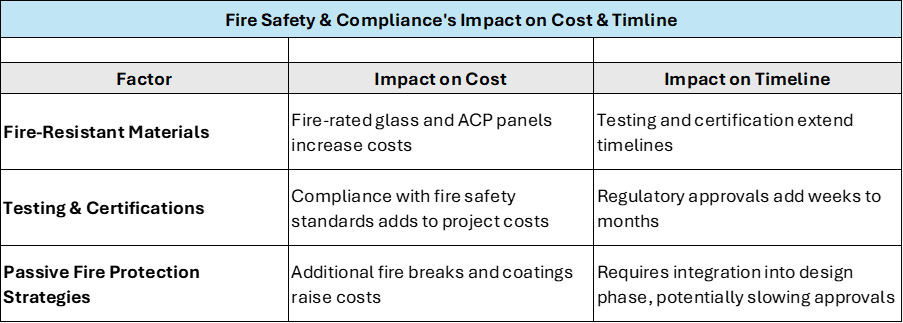
• Customized vs. Standardized Designs: Custom facade designs with unique geometries increase engineering complexity, requiring additional time for structural analysis, prototyping, and approvals.
• Load-Bearing Considerations: Engineering choices impact how much load the facade adds to the building structure, affecting material selection and reinforcement needs.
• Seismic & Wind Load Factors: Advanced engineering ensures facades can withstand local environmental conditions, influencing both cost and time due to additional structural requirements.

• Smart Facades: Dynamic shading, photovoltaic integration, and energy-efficient glazing reduce operational costs but require sophisticated engineering.
• Lifecycle Cost Analysis: Facades engineered for high insulation and minimal thermal bridging provide long-term savings on energy bills, balancing higher upfront costs.
• Material Selection & Carbon Footprint: Sustainable facades using recycled or eco-friendly materials may qualify for green certifications, but sourcing can impact timelines.

• Fire-Resistant Materials: Engineering choices for fire-rated glass, aluminum composite panels (ACP), or ceramic facades affect both cost and regulatory approvals.
• Testing & Certifications: Compliance with global and regional fire safety standards (e.g., NFPA, BS EN, IS codes) impacts project timelines.
• Passive Fire Protection Strategies: Integration of fire breaks, smoke vents, and flame-resistant coatings adds cost but improves building safety.

• Building Information Modeling (BIM): Digital engineering speeds up decision-making, minimizes design errors, and improves coordination among teams.
• 3D Printing & Computational Design: Advances in engineering allow rapid prototyping of complex facade elements, reducing delays.
• Robotic & Automated Installation: Cutting-edge engineering solutions reduce labor dependence and enhance precision.

Different facade systems influence construction speed and budget requirements. Below is a comparative analysis of common systems:

• Cost per m²: The unitized curtain wall is the most expensive but offers efficiency in energy performance. Stick-built curtain walls and brick & masonry are more cost-effective initially but require extensive labor.
• Installation Speed: Unitized and precast concrete panels allow for rapid installation, reducing project delays.
• Labor Requirement: Stick-built curtain walls and brick & masonry demand higher labor input, increasing timelines and labor costs.
• Maintenance Cost: Unitized systems and ventilated facades have lower maintenance needs compared to stick-built curtain walls.
• Energy Efficiency: Ventilated facades and unitized curtain walls provide superior insulation, leading to long-term cost savings.
A significant portion of facade costs is attributed to labor expenses. Below is a detailed comparison of labor costs across different facade engineering techniques.

The choice of installation technique can significantly affect project costs and timelines.

• Cost Impact: Prefabrication and automation come with higher initial investments but reduce long-term costs.
• Timeline Impact: Prefabrication and automation accelerate installation, while on-site and manual assembly slow it down.
• Efficiency: Automated and prefabricated methods improve precision and reduce human error, leading to better overall outcomes.
Modern facade engineering techniques optimize both cost and efficiency.

• Structural Optimization: Reduces material wastage and enhances durability, offering cost savings.
• Material Efficiency: Using high-quality, precisely engineered materials minimizes waste and extends lifespan.
• Thermal Considerations: Investing in thermal insulation can lower energy costs over time, despite higher initial expenses.
To understand the real-world impact, we compare three facade systems—unitized curtain walls, stick-built curtain walls, and ventilated facades—on a 25-story commercial building with 20,000 m² of facade area.



• Facade engineering directly impacts construction costs and timelines, requiring careful material and system selection.
• Advanced technologies such as prefabrication, BIM, and automated installation can optimize efficiency and reduce costs.
• Sustainability and fire compliance considerations play a crucial role in the long-term feasibility of facade projects.
At ISE, we provide expert facade engineering solutions tailored to your project's specific needs. Our approach ensures:
• Cost Optimization: We analyze materials, labor, and installation techniques to deliver cost-effective solutions.
• Time Efficiency: We incorporate advanced digital tools and prefabrication techniques to speed up construction timelines.
• Regulatory Compliance: We ensure your facades meet fire safety and energy efficiency standards, reducing project risks.
• Sustainability Focus: We integrate eco-friendly materials and energy-efficient designs to lower long-term operational costs.

Contact us today to discover how our innovative facade engineering solutions can enhance your next construction project, minimize, optimize, save and reduce project cost and timeline.
To explore ISE Façade Consultancy expertise, visit https://www.ise.group/services